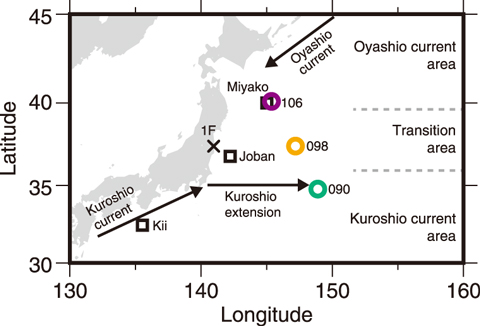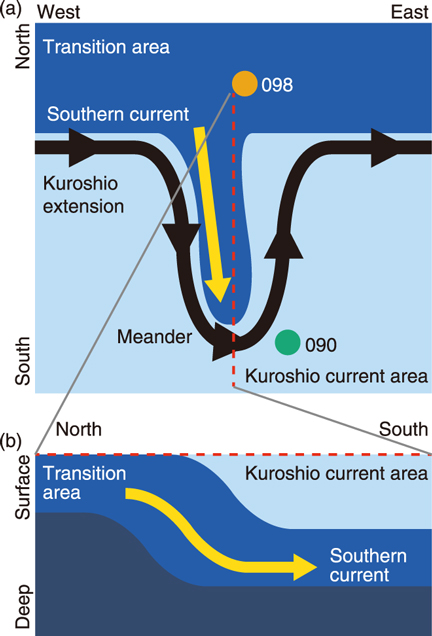
Fig.1-32 Seawater sampling locations

Fig.1-33 Vertical distribution of 129I in each oceanic area before and after the accident

Fig.1-34 A conceptual diagram of the reproduced seawater current
The accident at the TEPCO’s Fukushima Daiichi NPS (1F) released radionuclides into the ocean. Many researches were carried out to understand the migration of radionuclides in the ocean. However, as many of these researchers have focused on the migration of radionuclides within surface layer, this work aimed to study the migration of radionuclides to deep layer.
As many deep-seawater samples were required to do so, a radionuclides detectable from a small sample volume was desired. Therefore, the vertical distribution of iodine-129 (129I)was studied, as 129I is detectable from 1 L of seawater using accelerator mass spectrometry; radiocesium (1 Bq/m3) detection requires 20 L of seawater. In the western North Pacific Ocean, the Oyashio and Kuroshio currents move from north and south, respectively, and provide the transitional seawater between two currents. To clarify the depth profile in the western North Pacific, seawater samples were collected from surface to a depth of 1000 m within the Oyashio current, Kuroshio current and transition areas (Fig.1-32).
The resulting depth profiles of 129I are shown in Fig.1-33,including data regarding the depth profiles of 129I before the accident. Comparing between the vertical distribution before and after the accident demonstrates a clear increase in concentration caused by the 1F accident occurred from the surface to 150 m and 200 m depth at the Oyashio current and transition areas, respectively, and in the subsurface layer around a depth of 400 m at the Kuroshio current area. To elucidate the subduction to the subsurface layer, the seawater flow was analyzed using a data set that reproduced the flow velocity. As a result, the Kuroshio Extension current which was left from offshore of Chiba was meandering, and a southern current from transition area occurred by the influence of the meander and the southern current was subducted under the seawater of the Kuroshio current area, as the seawater density of the southern current was higher than that of the Kuroshio current area (Fig.1-34).
These results led to the discovery of new oceanographic findings that the radionuclides released by the 1F accident subducted rapidly due to the influence of the meander of the Kuroshio Extension.